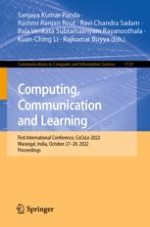2022 | Book
Computing, Communication and Learning
First International Conference, CoCoLe 2022, Warangal, India, October 27–29, 2022, Proceedings
Editors: Sanjaya Kumar Panda, Rashmi Ranjan Rout, Ravi Chandra Sadam, Bala Venkata Subramaanyam Rayanoothala, Kuan-Ching Li, Rajkumar Buyya
Publisher: Springer Nature Switzerland
Book Series : Communications in Computer and Information Science
